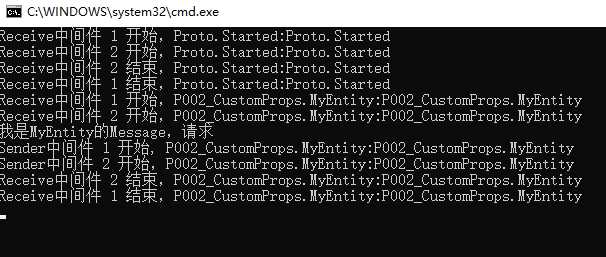《通过C#学Proto.Actor模型》之Prpos
2021-07-14 12:14
标签:super async class microsoft turn core ros col 构造 在第一篇Proto.Actor博文中,HelloWorld的第一行真正代码是: var props = Actor.FromProducer(() => new HelloActor()); 这个返回的变量props就是一个Props的对象,它是负责创Actor实例,以及配置Actor实例,并且产Actor上下文Context(类似asp.net中的Context)。 Props对象产生通常是用Actor.FromProducer或Actor.FromFunc产生,不过也可能实例化,实体例时可以给Actor做一系列配置,如下代码: 你会发现,Demo中,总有一个实例类+一个Actor类,这是构成Actor模型的必备,Actor类就是主体,实体类就是Actor类运算的载体,所以它们总是如影随形。 第15 行到第21 行代码含意以后会解释。 这里说Recevie和Sender的中间件,这里很像一个AOP,可以在调用某个行为前后作处理统一的处理,比如日志,权限等统一的规则,也和asp.net core里的中件间如出一辙【如里你是一个asp.net core码友,熟悉的Context,熟悉的next(),还有熟悉的Middleware】。 现在可以自己运行一下分析一下结果吧: 《通过C#学Proto.Actor模型》之Prpos 标签:super async class microsoft turn core ros col 构造 原文地址:https://www.cnblogs.com/axzxs2001/p/9540265.html 1 using Proto;
2 using Proto.Mailbox;
3 using System;
4 using System.Threading.Tasks;
5
6 namespace P002_CustomProps
7 {
8 class Program
9 {
10 static void Main(string[] args)
11 {
12 var props = new Props()
13 //用道具代理返回一个IActor实例
14 .WithProducer(() => new MyActor())
15 //默认调度器用线程池,邮箱中最多300个消息吞吐量
16 .WithDispatcher(new ThreadPoolDispatcher { Throughput = 300 })
17 //默认邮箱使用无界队列
18 .WithMailbox(() => UnboundedMailbox.Create())
19 //默认策略在10秒的窗口内最多重新启动子Actor 10次
20 .WithChildSupervisorStrategy(new OneForOneStrategy((who, reason) =>
21 SupervisorDirective.Restart, 10, TimeSpan.FromSeconds(10)))
22 //可以将中间件链接起来以拦截传入和传出消息
23 //接收中间件在Actor接收消息之前被调用
24 //发送者中间件在消息发送到目标PID之前被调用
25 .WithReceiveMiddleware(
26 next => async c =>
27 {
28 Console.WriteLine($"Receive中间件 1 开始,{c.Message.GetType()}:{c.Message}");
29 await next(c);
30 Console.WriteLine($"Receive中间件 1 结束,{c.Message.GetType()}:{c.Message}");
31 },
32 next => async c =>
33 {
34 Console.WriteLine($"Receive中间件 2 开始,{c.Message.GetType()}:{c.Message}");
35 await next(c);
36 Console.WriteLine($"Receive中间件 2 结束,{c.Message.GetType()}:{c.Message}");
37 })
38 .WithSenderMiddleware(
39 next => async (c, target, envelope) =>
40 {
41 Console.WriteLine($"Sender中间件 1 开始, {c.Message.GetType()}:{c.Message}");
42 await next(c, target, envelope);
43 Console.WriteLine($"Sender中间件 1 结束,{c.Message.GetType()}:{c.Message}");
44 },
45 next => async (c, target, envelope) =>
46 {
47 Console.WriteLine($"Sender中间件 2 开始,{c.Message.GetType()}:{c.Message}");
48 await next(c, target, envelope);
49 Console.WriteLine($"Sender中间件 2 结束,{c.Message.GetType()}:{c.Message}");
50 })
51 // 默认的 spawner 构造 Actor, Context 和 Process
52 .WithSpawner(Props.DefaultSpawner);
53
54 //从props衍生pid,pid代理一个actor的地址
55 var pid = Actor.Spawn(props);
56 //把Hello对象交给HelloActor处理
57 pid.Tell(new MyEntity
58 {
59 Message = "我是MyEntity的Message,请求"
60 });
61 Console.ReadLine();
62 }
63 }
64
65 public class MyActor : IActor
66 {
67 public Task ReceiveAsync(IContext context)
68 {
69 if (context.Message is MyEntity myEntity)
70 {
71 Console.WriteLine(myEntity.Message);
72 context.Tell(context.Sender, new MyEntity() { Message = "我是MyEntity的Message,应答" });
73 }
74 return Actor.Done;
75 }
76 }
77 public class MyEntity
78 {
79 public string Message { get; set; }
80 }
81 }

上一篇:c#设计模式系类:亨元模式